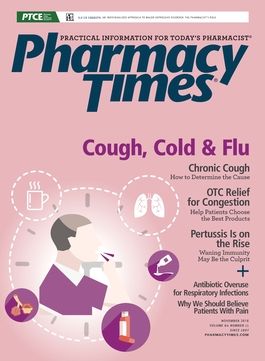Publication
Article
Pharmacy Times
Sick Days Because of a Cold or a Cough: How Brown Bagging Can Bring Clarity
Author(s):
Brown bag consults can be essential educational and safety tools to measure and ensure quality care.
Brown bag consults can be essential educational and safety tools to measure and ensure quality care. By asking patients to bring in all their current medications, including OTC, mail-order, specialty, and herbal products, pharmacists can guarantee appropriate and up-to-date care.
Pharmacists are key providers in the continuum of care, consistently identifying potential problems and concerns that may require follow-up with prescribers or a medication therapy management session. It is essential that a pharmacist’s workflow allow for brown bag consults, which can do the following:
- Develop the pharmacist—patient relationship to help create better individualized service, forge patient loyalty and trust, and prevent medical errors
- Provide insight into a patient’s lifestyle and quality of care
- Show how well patients understand their conditions and medications
Pharmacists can make a positive impact in identifying and helping patients with flulike symptoms. “I’m not feeling well…” are the words every employer, parent, and spouse dreads hearing. The change in seasons and the more time indoors mean cold and cough season is upon us. It is time to stock up on hand sanitizers, lozenges, and tissues. Yet no matter how frequently health care professionals encourage eligible patients to receive their annual flu shots, we know that not all of them will get it. This fact makes it even more important to remind patients to cover their mouths when they cough or sneeze and to thoroughly wash their hands throughout the day during flu season.
TC is a 31-year-old woman who has been visiting the pharmacy during the past year to have her prescriptions filled. She is a part-time graduate student at the local university and works as a human resources representative during the day. TC is browsing the cold and cough medication aisle in the pharmacy, picking up box after box to view the ingredients and labels. She is coughing and wiping her nose frequently. When TC comes to the counter to collect a monthly prescription she refilled, she hands you various OTC medications. You ask how she is feeling and what you can do to help. TC says that she feels very stuffed up and that she cannot stop trying to cough up mucus caught in her throat. She stresses how her boss insisted that she go home, rest, and not come back until she has shaken her cold. TC is a bit worried because she relies on work for money to go to school. You ask whether she would be interested in participating in a quick brown bag session. You explain what happens during a brown bag consult and tell TC that you are interested in reviewing her medications. She agrees to a consult, and you have some extra time, so you meet her in the counseling area after reviewing her profile.
You find the following in her brown bag:
- Acetaminophen/hydrocodone, 5/500 every 4 to 6 hours daily, as needed (3 of 4 refills)
- Alprazolam, 0.5 mg, 1 to 2 tablets by mouth, as needed
- Duloxetine, 30 mg, daily
- Ibuprofen, 600 mg, every 6 hours, as needed (usually filled 3 to 4 days early)
- Ortho Tri-Cyclen Lo, daily
You have questions and suggestions about TC’s medications and health. During your discussion, she shares that she also takes a multivitamin and extra vitamins B and D and admits that she has recently started vaping. TC knows and understands the consequences of smoking but thinks vaping carries no risks. She explains that vaping eases periodic depression, helps her relax, and reduces her stress. You ask TC about her stress level, and she attributes it to demands at school, eating and sleeping disturbances as a result of her cough and sore throat, her workload, and a lack of exercise. You explain how depression and stress can lead to illness and counsel her on managing her stress. TC agrees to explore more healthy stress management options and to talk with her primary care physician about the dosing of her alprazolam and duloxetine, which have never been modified or titrated.
You review the OTC medications that she hands you and pull out multiple combination products. You tell TC that she does not need anything with additional acetaminophen and ibuprofen and explain the potential for drug toxicity. You also explain that the hydrocodone in the acetaminophen combination product should help suppress her cough. TC says that she has been taking her prescription ibuprofen and hydrocodone/acetaminophen more frequently because of her back pain and headaches. Despite this increase in usage, the hydrocodone has not reduced her coughing episodes. You suggest a single-use guaifenesin product, decongestant, and antihistamine instead. TC understands that her pain medications are not treating the root cause of her pain and agrees to consider seeing an acupuncturist or a chiropractor. You see that TC has also selected a compact humidifier, some throat lozenges, and a topical chest and throat aromatic. You agree with her nonpharmacologic choices and tell her that she should also drink lots of water.
TC agrees to check in with you later in the week after she contacts her primary care provider and thanks you. She promises to visit your pharmacy’s walk-in clinic or an urgent-care center if her cough worsens or becomes more frequent. TC also requests a flu shot, though she has never had one before.
How would you help TC? Would you have made additional or fewer recommendations?
Jill Drury, PharmD, is a clinical pharmacy specialist in Chicago, Illinois, and Milwaukee, Wisconsin. She earned her doctor of pharmacy degree from Midwestern University College of Pharmacy.







